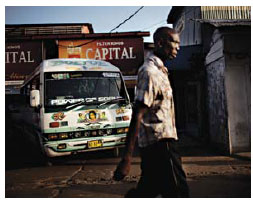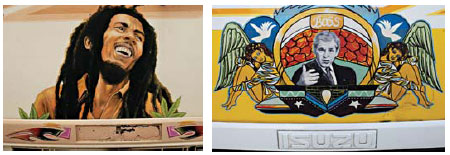Society
Art on wheels: the colorful buses of Suriname
Updated: 2011-04-10 07:54
By Simon Romero (New York Times)
|
Catching a ride with Bob Marley or George W. Bush. Photographs by Tomas Munita for The New York Times |
 |
PARAMARIBO, Suriname - Stroll through this city, perched between jungle and sea, and Suriname's past as a Dutch colony comes into view: stately mansions, Lutheran churches, street names with vast streams of consonants and vowels.
But the colorful minibuses gliding by show a different side of the evolution of this diverse South American country.
Drivers adorn these "wilde bussen" with hand-painted illustrations of the heroes, outlaws, religious temples and musical subcultures that beguile this nation, home to an ethnic variety that includes Javanese, Indians, Chinese, indigenous groups, mixed race Creoles and Maroons, descendants of runaway slaves.
Bollywood stars like Amitabh Bachchan and Sameera Reddy make many appearances, as do singers like Capleton and Bob Marley.
Even a dizzying span of American figures, from Malcolm X to George W. Bush, whiz by on buses.
"You paint your bus to attract riders," said one driver, Satish Yokhoe, 29. He adorned his with a painting of the Bollywood screen idol Kareena Kapoor and the words "Ne Bluf Mi," a phrase in Sranan Tongo, the Creole language that is Suriname's lingua franca, that translates as "Don't Challenge Me."
"If you leave your bus blank," said Mr. Yokhoe, "you might as well get off the street."
Suriname is not alone in boasting painted buses. It has competition from Colombia's chivas, used for mobile revelry, Haiti's tap-taps, Panama's diablos rojos (red devils) and the jeepneys of the Philippines.
Nishar Khodabaks has captured the sultriness of Priyanka Chopra, an Indian actress and former Miss World, in one bus painting. And Morales Peerwijk has depicted Desi Bouterse, the strongman who led Suriname in the 1980s and who returned to power last year.
Some commuters do not care how their bus is painted, as long as it gets them to where they are going. Others are more discriminating. "I always look for the Jah Cure bus," said Amanda Safira, 18, referring to the dreadlocked singer, born Siccature Alcock in Jamaica.
Mudflaps are illustrated with handguns or pipes of ganja. One black-and-white painting depicts Mr. Bush and Saddam Hussein, side by side, looking uncomfortable.
His assistant, Radjesh Hiera, 41, offered his own assessment of Mr. Khodabaks's paintings, which can cost as much as $1,300 for the "package," illustrating an entire bus. "He is the Rembrandt of Paramaribo," Mr. Hiera said. "You pay money for quality."
Suriname's painted buses face threats in an age of digital piracy. Entrepreneurs have begun downloading digital photos of the same idols painted on buses, making sticker versions for the buses that sell for a fraction of what a painting costs.
One bus artist, Ramon Bruyning, said the best way to defeat them was to keep focused on the cultural and political pulse of this city's streets. Aside from movie stars and singers, "The people want paintings of someone strong or defiant," he said.
"Qaddafi will be my next subject," said Mr. Bruyning, referring to the embattled Libyan leader, Colonel Muammar el-Qaddafi. "I want to paint him before he is gone."
The New York Times
Specials

Share your China stories!
Foreign readers are invited to share your China stories.

Art auctions
China accounted for 33% of global fine art sales.

Waiting for drivers' seat
Lack of sponsorship appears to be why Chinese drivers have yet to race in a Formula 1 event
